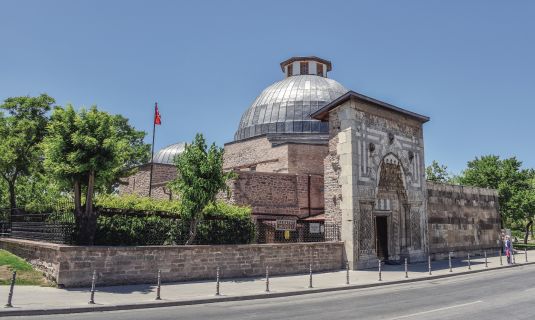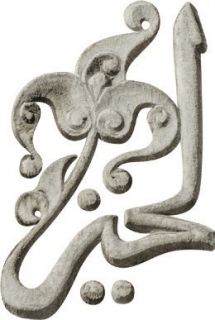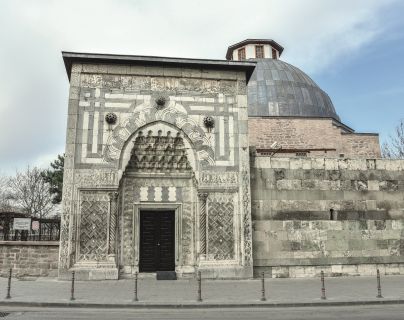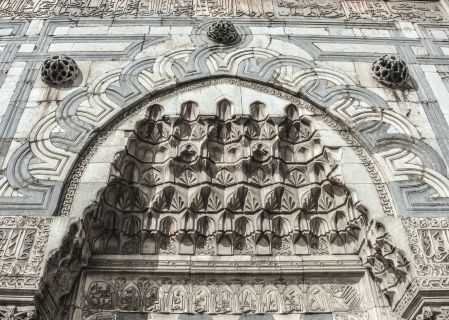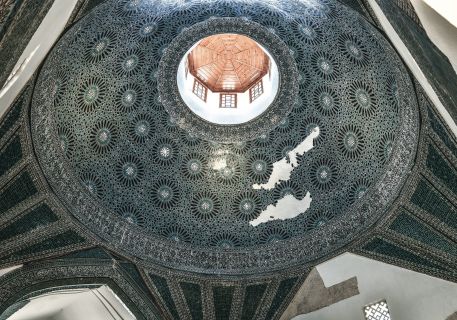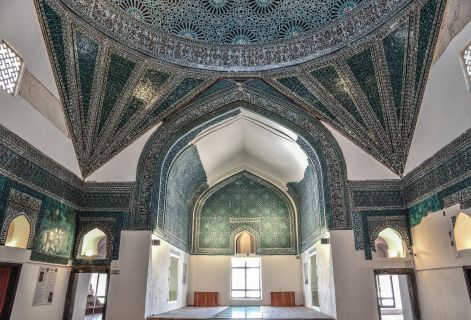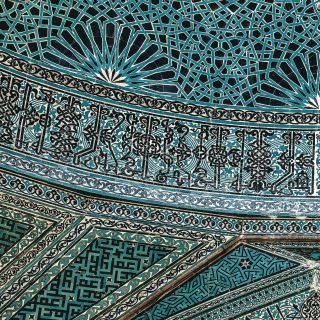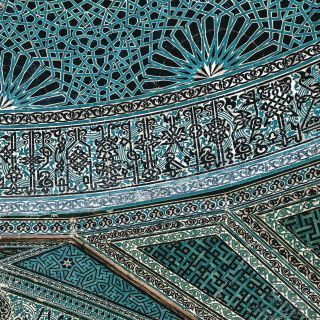KARATAY MADRASA
Turkiye KONYA 13th Century
1251/52
This single-story madrasa with a covered courtyard and single iwan is located in Tarla neighbourhood of Selçuklu district.
The portal is situated at the south end of the east façade; the rectangular doorway placed within a pointed-arched muqarnas niche is flanked by twisted colonnettes on either side. Over the framing arch is the inscription plaque. The portal features geometric interlacing decoration formed by grey and white marble. The framing arch has Zangid knots, and in the spandrels and top are three bosses in openwork. Another point worth noting is that the five rows of muqarnas filling is truncated at the top rather than terminating in a point. The border framing the doorway on three sides has 28 selected hadith (sayings of the Prophet).
The portal leads to a garden-like open area today; however, originally there was a square entrance hall covered with a dome here. A doorway opened later in the northwest of this area leads directly into the central courtyard. This large square hall is covered with a large dome rising on triangular pendentives and the centre of the dome is open like an oculus. This courtyard has a pool. The rooms that once surrounded this courtyard on the north, east and south sides have disappeared in time.
On the west side is the main iwan covered with a pointed barrel vault opening out as a pointed arch. It is flanked with a square room on either side; the one on the south is the tomb of the Seljuk Vizier Jalal al-Din Karatay, the patron of the madrasa. The square room to the north was also originally covered with a dome as inferred from extant traces. Another room with a dome is conjectured for the northeast corner of the courtyard; however, the crooked line of the building in that direction suggests a vault.
The madrasa was built with local cut Sille stone and rubble but the tomb features transition and the dome in brick.
The madrasa stands out with its bichrome stonework on the portal and magnificent tilework inside.
The tile mosaic decoration inside features cut tiles in turquoise, dark blue and aubergine purple forming geometric and stylised vegetal motifs. The tiles on the curving interior surface of the central dome are highly impressive. An intricate composition of 24-pointed stars forming circles and knotted ribbons in between rise from the foot of the dome and extend up to the oculus. On the drum and around the oculus are Qur’anic verses is kufic script; on the triangular pendentives are the names of Muhammad, Abu Bekr, Ali, Omar, Othman, Dawud (David), Isa (Jesus) and Musa (Moses) written in kufic calligraphy and on the iwan arch are the Basmala and the Verse of the Throne.
The madrasa was restored in 1954 and today serves as the Museum of Tilework.
The single line Arabic inscription on the portal states that it was commissioned in 1251/52 by Karatay, son of Abdullah; its inauguration ceremony was attended by the renowned scholars of the time such as Rumi, Shams of Tabriz, Sadr al-Din of Konya, Qadi Siraj alDin Mahmud of Urmia, and Sharaf al-Din Musli. The madrasa had a special place for Rumi and his whirling dervishes and it is known that they had used its pool for making sherbet for the Mawlana Dergah.
The patron given in the inscription is the Seljuk Vizier Jalal al-Din Karatay. It is known that he passed away in Kayseri in 1254 and his body was brought to Konya and interred at the madrasa. Its waqfiyya was prepared in 1253/54 during the reign of Sultan Izz al-Din Kay Qawus II and was later amended in 1254/55 and 1261/62; accordingly, the madrasa was endowed to scholars, holy people and experts in Islamic law from all four sects on the condition that the head teacher was of Hanafi sect and knew well the sharia, hadith, fundamentals and subdivisions and contrary sciences.

